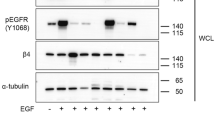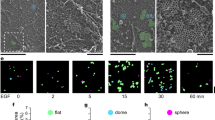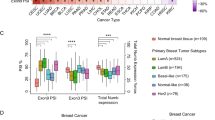Abstract
Intense investigation has centered on understanding the regulation of integrin cell adhesion receptors. In the present study, we propose that variant N-glycosylation represents an important mechanism for regulation of β1, but not β3 or β5 integrins. We find that expression of oncogenic ras in HD3 colonocytes causes increased α2–6 sialylation of β1 integrins, whereas expression of dominant-negative ras induces decreased α2–6 sialylation, relative to cells with wild-type ras. In contrast, neither β3 nor β5 integrins are α2–6 sialylated, regardless of the state of ras activation. Results from RT–PCR analyses suggest that differential integrin sialylation is due to a ras-dependent alteration in the expression of ST6Gal I, the enzyme that adds α2–6-linked sialic acids. Cells that express differentially sialylated β1 integrins exhibit altered adhesion to collagen I (a β1 ligand), but not to vitronectin (a β3 or β5 ligand). Similarly, the enzymatic removal of cell surface sialic acids from control cells alters binding to collagen, but not to vitronectin. Finally, using a cell-free receptor/ligand-binding assay, we show that purified, desialylated α1β1 integrins have diminished collagen-binding capability, providing strong evidence that sialic acids play a causal role in regulating β1 integrin function.
This is a preview of subscription content, access via your institution
Access options
Subscribe to this journal
Receive 50 print issues and online access
$259.00 per year
only $5.18 per issue
Buy this article
- Purchase on Springer Link
- Instant access to full article PDF
Prices may be subject to local taxes which are calculated during checkout







Similar content being viewed by others
References
Akiyama SK, Yamada SS and Yamada KM . (1989). J. Biol. Chem., 264, 18011–18018.
Aplin AE, Howe A, Alahari SK and Juliano RL . (1998). Pharmacol. Rev., 50, 197–263.
Asada M, Furukawa K, Segawa K, Endo T and Kobata A . (1997). Cancer Res., 57, 1073–1080.
Bellis SL, Newman E and Friedman EA . (1999). J. Cell. Physiol., 181, 33–44.
Braut-Boucher F, Font J, Pichon J, Paulin Y, Boukhelifa M, Aubery M and Derappe C . (1998). Leuk. Res., 22, 947–952.
Dall'Olio F, Malagolini N, di Stefano G, Minni F, Marrano D and Serafini-Cessi F . (1989). Int. J. Cancer, 44, 434–439.
Easton EW, Bolscher JG and van den Eijnden DH . (1991). J. Biol. Chem., 266, 21674–21680.
Gangopadhyay A, Perera SP and Thomas P . (1998). Hybridoma, 17, 117–123.
Gessner P, Riedl S, Quentmaier A and Kemmner W . (1993). Cancer Lett., 75, 143–149.
Guo HB, Lee I, Kamar M, Akiyama SK and Pierce M . (2002). Cancer Res., 62, 6837–6845.
Heino J, Ignotz RA, Hemler ME, Grouse C and Massague J . (1989). J. Biol. Chem., 264, 380–388.
Hughes PE, Renshaw MW, Pfaff M, Forsyth J, Keivens VM, Schwartz MA and Ginsberg MH . (1997). Cell, 88, 521–530.
Jasiulionis MG, Chammas R, Ventura AM, Travassos LR and Brentani RR . (1996). Cancer Res., 56, 1682–1689.
Kim LT, Ishihara S, Lee CC, Akiyama SK, Yamada KM and Grinnell F . (1992). J. Cell Sci., 103, 743–753.
Kinashi T, Katagiri K, Watanabe S, Vanhaesebroeck B, Downward J and Takatsu K . (2000). J. Biol. Chem., 275, 22590–22596.
Le Marer N, Laudet V, Svensson EC, Cazlaris H, Van Hille B, Lagrou C, Stehelin D, Montreuil J, Verbert A and Delannoy P . (1992). Glycobiology, 2, 49–56.
Le Marer N and Stehelin D . (1995). Glycobiology, 5, 219–226.
Lenter M and Vestweber D . (1994). J. Biol. Chem., 269, 12263–12268.
Leppa S, Heino J and Jalkanen M . (1995). Cell Growth Differ., 6, 853–861.
Li M, Andersen V and Lance P . (1995). Clin. Sci. (Lond.), 89, 397–404.
Lise M, Belluco C, Perera SP, Patel R, Thomas P and Ganguly A . (2000). Hybridoma, 19, 281–286.
Ma J, Simonovic M, Qian R and Colley KJ . (1999). J. Biol. Chem., 274, 8046–8052.
Moss L, Prakobphol A, Wiedmann TW, Fisher SJ and Damsky CH . (1994). Glycobiology, 4, 567–575.
Oz OK, Campbell A and Tao TW . (1989). Int. J. Cancer, 44, 343–347.
Praetorius J and Spring KR . (2002). Exp. Cell. Res., 276, 52–62.
Pretzlaff RK, Xue VW and Rowin ME . (2000). Cell Adhes. Commun., 7, 491–500.
Recchi MA, Hebbar M, Hornez L, Harduin-Lepers A, Peyrat JP and Delannoy P . (1998). Cancer Res., 58, 4066–4070.
Sata T, Roth J, Zuber C, Stamm B and Heitz PU . (1991). Am. J. Pathol., 139, 1435–1448.
Semel AC, Seales EC, Singhal A, Eklund EA, Colley KJ and Bellis SL . (2002). J. Biol. Chem., 277, 32830–32836.
Symington BE, Symington FW and Rohrschneider LR . (1989). J. Biol. Chem., 264, 13258–13266.
Van de Water L, Aronson D and Braman V . (1988). Cancer Res., 48, 5730–5737.
Vandamme V, Cazlaris H, Le Marer N, Laudet V, Lagrou C, Verbert A and Delannoy P . (1992). Biochimie, 74, 89–99.
Veiga SS, Chammas R, Cella N and Brentani RR . (1995). Int. J. Cancer, 61, 420–424.
von Lampe B, Stallmach A and Riecken EO . (1993). Gut, 34, 829–836.
Wadsworth S, Halvorson MJ, Chang AC and Coligan JE . (1993). J. Immunol., 150, 847–857.
Woodside DG, Liu S and Ginsberg MH . (2001). Thromb. Haemost., 86, 316–323.
Yan Z, Chen M, Perucho M and Friedman E . (1997). J. Biol. Chem., 272, 30928–30936.
Zhang Z, Vuori K, Wang H, Reed JC and Ruoslahti E . (1996). Cell, 85, 61–69.
Zheng M, Fang H and Hakomori S . (1994). J. Biol. Chem., 269, 12325–12331.
Zhu Y, Srivatana U, Ullah A, Gagneja H, Berenson CS and Lance P . (2001). Biochim. Biophys. Acta, 1536, 148–160.
Acknowledgements
This project was supported by NIH Grants RO1CA84248 (SLB) and 5 P60 AR 20614-23 (SLB), as well as an institutional minigrant from the American Cancer Society (SLB), and a grant from the University of Alabama Cell Adhesion and Matrix Research Center (SLB).
Author information
Authors and Affiliations
Corresponding author
Rights and permissions
About this article
Cite this article
Seales, E., Jurado, G., Singhal, A. et al. Ras oncogene directs expression of a differentially sialylated, functionally altered β1 integrin. Oncogene 22, 7137–7145 (2003). https://doi.org/10.1038/sj.onc.1206834
Received:
Revised:
Accepted:
Published:
Issue Date:
DOI: https://doi.org/10.1038/sj.onc.1206834
Keywords
This article is cited by
-
LAMTOR5 raises abnormal initiation of O-glycosylation in breast cancer metastasis via modulating GALNT1 activity
Oncogene (2020)
-
β4GALT1 controls β1 integrin function to govern thrombopoiesis and hematopoietic stem cell homeostasis
Nature Communications (2020)
-
Sox2 promotes expression of the ST6Gal-I glycosyltransferase in ovarian cancer cells
Journal of Ovarian Research (2019)
-
Sialylation is involved in cell fate decision during development, reprogramming and cancer progression
Protein & Cell (2019)
-
Sialylation of N-glycans: mechanism, cellular compartmentalization and function
Histochemistry and Cell Biology (2017)



